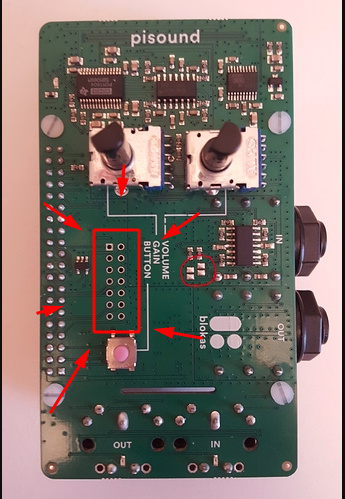Hi,
I like to use the Pisound on my Project. But I also like to use a eInk Display. So I was wondering, if the Pisound needs all the GPIO Pins or is it possible to use a Breadboard and connect the Pisound manually and use the free GPIOs for other stuff?
Best regards
Hi, see https://blokas.io/pisound/docs/specs/#raspberry-pi-pins-used-by-pisound. The ‘Pinout of Pisound Header’ lists all the unused GPIOs, routed to a separate smaller header.
Sorry noob here. How do you connect into that separate header? Can’t see any pinout exposed by the pisound board
It’s just 2x7 holes in the PCB. If you like, you can solder your own male or female header for use with jumper cables, or just solder wires directly to the desired holes.
This picture is of an earlier version, check the picture here: Soldering the 5V bias jumpers
Thanks for the quick reply.
This picture is of an earlier version
oh ok
check the picture here: Soldering the 5V bias jumpers
I actually would like to use the I2C pins to drive an oled, which I read they are available (not used by pisound, Detailed Specs - Pisound Documentation) but can’t find them exposed in the board, even in that picture
oh, got it!

Hi @Giedrius.
Sorry to unearth this old post. But it often come to results of search about unused pin on pisound.
Did I understand correctly that, by using the separate header, I can use all BCM pin mentioned as general purpose?
I mean… If I don’t use any other hat or i2c.
(second OT question just incase
I’m looking for some hat including pull up or down resistor for making our installation faster to connect. Saw that pishop or modpi stuff but doesn’t seem available. If you got a reference.)
Yes, the pins on 2x7 header are available for use for any purpose. I²C is not used by Pisound at all.
Not sure I know what you mean. Pull up / down resistors on which pins? ![]()
Hi Giedrus,
I’m “just” looking for a faster/easier way for connecting buttons/sensors to the rasp.
I know some of GPIOs can be connected directly (like on Arduino, which includes pull up/down resistors on all pins) but I heard/read some of them on the rasp doesn’t have that. and we need to use external pull up/down resistors.
Maybe this is totally a misunderstanding and all GPIOs on Rasp (let’s say from Rasp 4 B to newest) got internal resistor that can be configured by software.
All of the BCM pins that I’ve used had internal pull up and down resistors, they just can’t be controlled through sysfs gpio class interface (for that you must write and load your own pinmux device tree overlays), but you can use libgpiod or gpiod utilities which give you control over the pull up / down resistors from user space.
Is it a problem in practice ? I mean, can it drives to burn something at boot time (this is the first dark example coming in mind ![]() )
)
If there’s no unexpected shorts or connections, it will be fine. ![]()
Thanks a lot, @Giedrius
btw, I’m using pisound (a lot) as the interface for rnbo based development with max (I’m both ableton + max certified trainer, but artist too). This is amazing. Recently worked on some installations using data sonification, especially.
